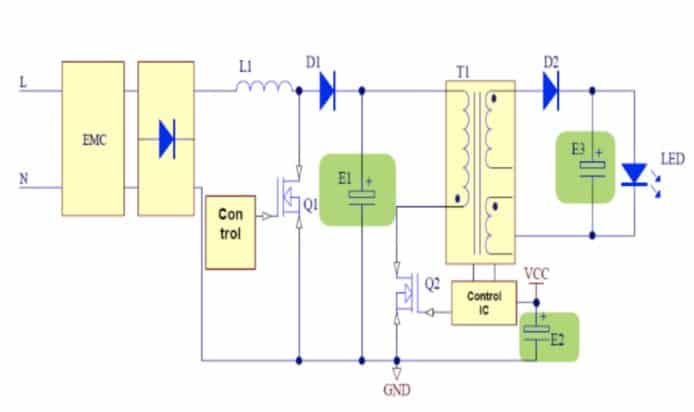This technical blog article written by Raul Wang, KYOCERA-AVX Components Corporation, explains benefits and use of Aluminum electrolytic capacitors in LED lighting circuits and provide selection guidelines of electrolytic, hybrid and polymer aluminum capacitor technologies.
Capacitors in LED Drivers
While relatively expensive, LED lighting is more reliable, more configurable, and uses significantly less electrical power for the same luminous output when compared to its incandescent, fluorescent, and halogen counterparts.
It is safe to say that LED luminaires have become the mainstay technology for consumer and industrial lighting applications. While relatively
expensive, LED lighting is more reliable, more configurable, and uses significantly less electrical power for the same luminous output when
compared to its incandescent, fluorescent, and halogen counterparts.
When coupled with regulatory requirements for efficiency, the LED lighting market is predicted to maintain more than 12% year-over-year growth for the near term (“LED Lighting Market Share & Growth Report, 2021-2028”).
However, the adoption of LED luminaires has been a long time in the making — it does not simply mean swapping out a lesser technology for an LED. Typically, numerous LEDs are required in tandem to replicate the luminous output of any competing light source.
These LEDs must be driven with a specific DC current and must simultaneously be cooled to prevent thermal damage. The supporting circuitry and mechanical ecosystem required for effective and reliable LED lighting are by no means trivial. One area of particular interest is the LED driver system that enables such a DC current mode device to run on existing AC mains power sources. The most common LED driver for running on AC mains power is the flyback converter shown in Figure 1.
Mosfets Q1 and Q2 control the energy transfer through transformer T1, and diode D2 rectifies the output to drive the LED or chain of LEDs. Because the LED is a current-controlled device, an additional current sensing circuit is required on the primary or secondary to act as feedback for voltage control. Capacitors E1, E2, and E3 are critical for voltage smoothing and proper power regulation.
Capacitors Selection
Referring to the aforementioned flyback driver design, engineers should choose capacitor E1 to be electrolytic to accommodate the high voltage and high required capacitance for smoothing the Input DC voltage.
The following characteristics are desirable and can be achieved with a standard aluminumbased device:
- 5000 Hrs @ -55 ℃ ~ 125 ℃
- Wide Voltage Range: 10~450V
- Wide size range
- Low leakage (DCL)
- Low-cost
Capacitor E2, on the other hand, is providing a supply voltage for the control circuit and requires slightly different characteristics. The recommended
device is a polymer aluminum capacitor owing to its capacitance stability across temperature and frequency, low inductance, and low ripple voltage. A polymer capacitor with the following characteristics are preferable:
- 5000 Hrs @ -55 ℃ ~ 105 ℃
- 10 ~ 220uF
- 16 ~ 125V
- Lower ESR
- Higher ripple
- Stability over temperature
- Longer life
For capacitor E3, either polymer or hybrid aluminum capacitors are suitable. Hybrid aluminum capacitors are a recommended product series for automotive lighting with AEC-Q200 certification because they offer low ESR and excellent lifetime and anti-vibration qualities. The following characteristics should be sufficient for the flyback output stage:
- 4,000 Hrs @-55℃ ~ +125℃
- 10 ~ 560uF
- 16 ~ 125V
- Solid and liquid electrolyte
- Low ESR
- Good temperature stability
- Low DCL
- Humidity resistance
- Consistent self‐healing
- Open failure
The following table summarizes the strengths and weaknesses of aluminum, polymer aluminum, and hybrid aluminum electrolytic capacitors:
Reliability
One of the most important tradeoffs that compensates for the increased cost and complexity of LED lighting is its long lifetime and high reliability. When considering the luminaire as a whole, it is critical that the lifetime of every part in the system is as good or better than the underlying LED. This includes the flyback driver and most importantly, the electrolytic capacitors within.
The method of wear-out for electrolytic capacitors follows an Arrhenius model just as in standard practice for most organic systems. Historically, the relationship for organic-based electrolytic capacitors is to double the lifetime for every 10°C reductions in operating temperature.
For polymer aluminum capacitors, the lifetime is significantly better than standard aluminum capacitors. This is captured in the following figure where the expected lifetime equations are compared.
One of the reasons that polymer aluminum capacitors last so long with graceful wear-out characteristics is the self-healing mechanism inherent to their construction.
As shown in Figure 3, when the dielectric breaks down at any point within the capacitor, the resulting current flow from anode to cathode creates a momentary but significant amount of heat. This heat reforms the polymer layer to create a new insulating barrier, cutting off the flow of current. This reformed dielectric region enables the capacitor to continue operating with only minute reductions in performance.
Standard, non-polymer electrolytics also offer some degree of self-healing. Because of the liquid electrolyte, oxygen is generated during electrolysis and can regrow a fault site due to dielectric impurities or micro cracks. This will reform the dielectric layer and reduce the leakage current. Over time, the liquid electrolyte will be depleted by this process and accelerate the normal wear-out stage of the lifetime.
High-Efficiency Aluminum Capacitors for LED Applications
While LED lighting has become the standard for efficiency and reliability, much of this success has been built upon the development and careful design of supporting circuitry and hardware. LED drivers, in particular, have stringent requirements for environmental ruggedness and wide voltage and current tolerances.
The electrolytic capacitors required to enable such characteristics must be carefully chosen for their electrical performance and lifetime. Aluminum, polymer, and hybrid electrolytics can be combined to balance their strengths and weaknesses in different aspects of the LED driver to realize a successful product.
